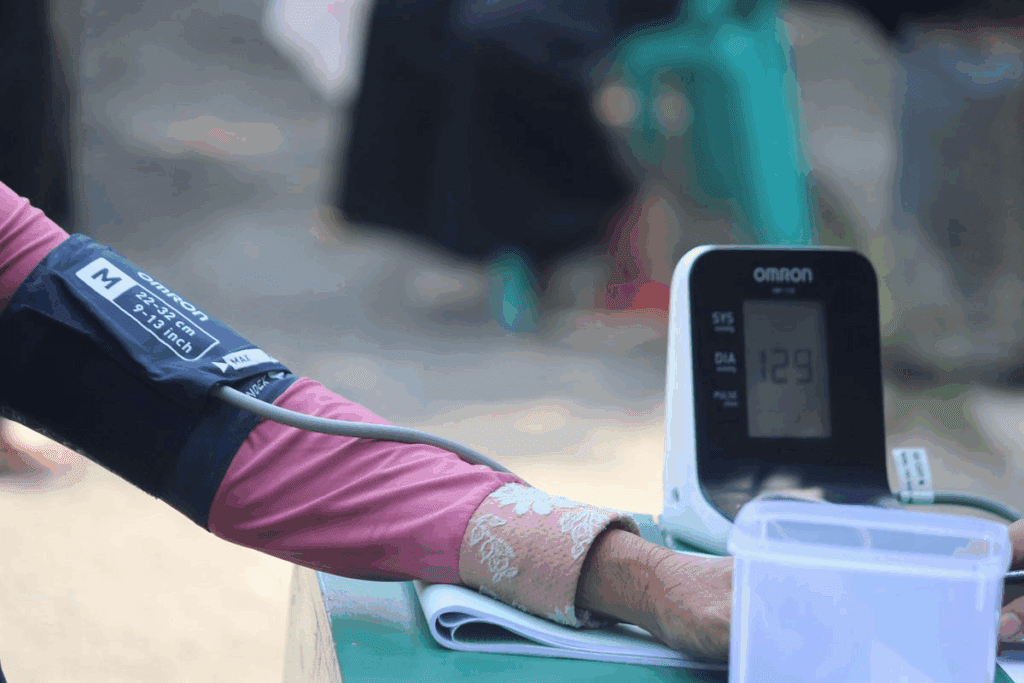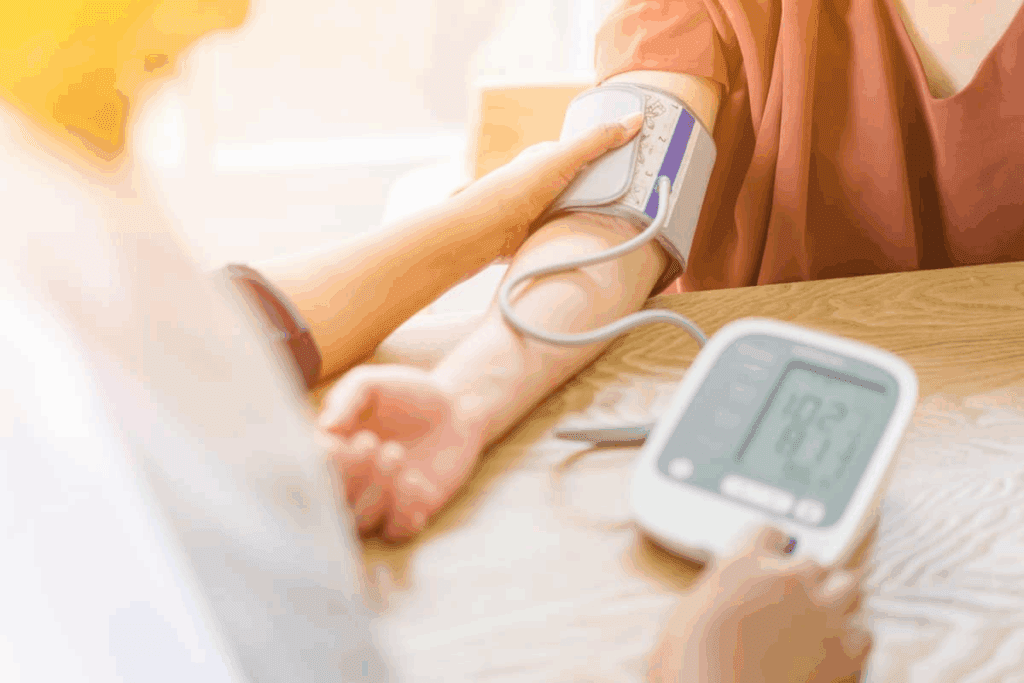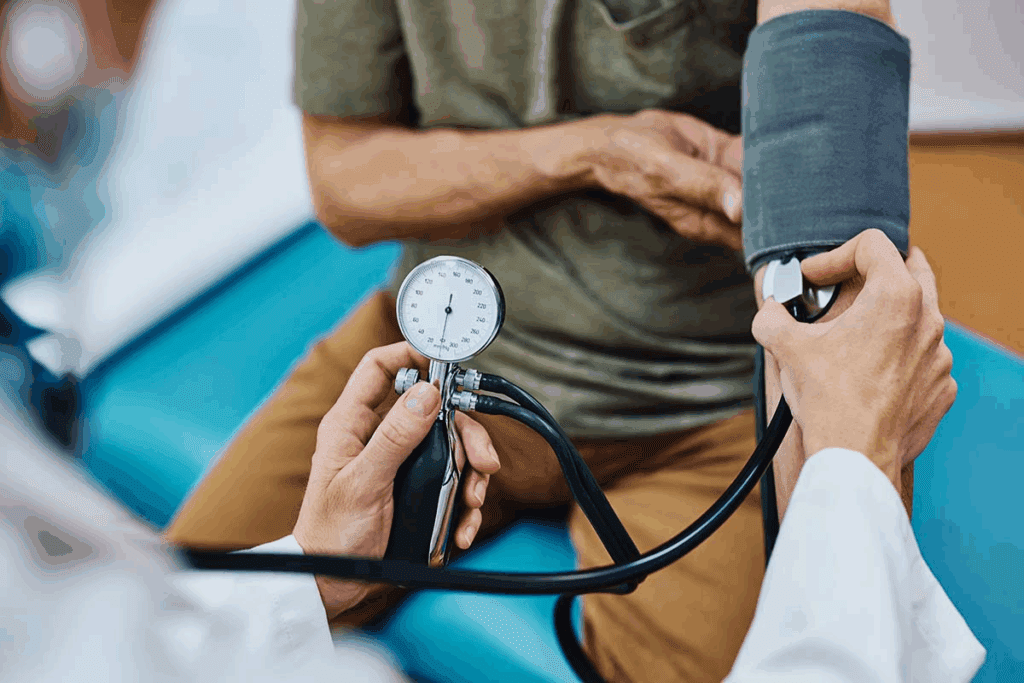
Low blood pressure, or hypotension, is serious if it doesn’t let blood flow to important organs. At Liv Hospital, Learn when is low blood pressure an emergency and signs that need urgent care.
Doctors say hypotension happens when blood pressure falls too low. This can hurt the heart, brain, and other vital parts. It’s very dangerous if not treated right away.
We aim to give top-notch healthcare, supporting patients from around the world. Knowing when hypotension is an emergency is key to quick help.

It’s important to know when low blood pressure is a serious issue. Low blood pressure, or hypotension, happens when blood pressure drops too low. This can lead to poor blood flow to important organs.
Low blood pressure is usually below 90/60 mmHg. But, what’s normal can vary from person to person. Normal blood pressure is between 90/60 mmHg and 120/80 mmHg. If it’s lower, it might be hypotension.
Blood pressure changes throughout the day. It can be affected by things like exercise, stress, and how hydrated you are.
It’s key to know the difference between normal and abnormal blood pressure. For example, a reading of 118/56 might be okay for some but not others. It depends on their usual blood pressure.
Here’s a table showing blood pressure categories:
| Blood Pressure Category | Systolic (mmHg) | Diastolic (mmHg) |
| Normal | 90-120 | 60-80 |
| Low Blood Pressure (Hypotension) | Below 90 | Below 60 |
| Elevated | 120-129 | Less than 80 |
| Hypertension Stage 1 | 130-139 | 80-89 |
Everyone has a different baseline for blood pressure. What’s low for one might be normal for another. Age, fitness, and health can all play a part.
Key Considerations:
Knowing these differences helps figure out if someone’s blood pressure is a worry.

Low blood pressure that doesn’t reach vital organs is a serious issue. It needs quick action. Hypotension, or low blood pressure, affects people differently.
Chronic hypotension means low blood pressure all the time. It’s common in athletes or those who are very thin. But, acute hypotension, or sudden drops in blood pressure, is more urgent.
Causes of acute hypotension include dehydration, infections, allergic reactions, or blood loss. These can cut off blood to vital organs, posing serious risks.
Symptoms are key in figuring out if low blood pressure is an emergency. Signs like dizziness, fainting, confusion, and chest pain show it’s getting serious.
Dizziness or fainting means the brain isn’t getting enough blood. Confusion or changes in mental state could mean the brain isn’t getting enough blood too. Chest pain might mean the heart isn’t getting enough blood.
Some factors make low blood pressure more urgent. These include being older, having heart problems, or other health issues like diabetes or neurological disorders.
| Risk Factor | Description | Emergency Concern |
| Older Age | Decreased physiological reserve | Higher risk of organ hypoperfusion |
| Heart Conditions | Impaired cardiac function | Increased risk of cardiac complications |
| Diabetes | Potential for autonomic dysfunction | Risk of orthostatic hypotension |
Knowing these risk factors and the difference between chronic and acute hypotension is key. Understanding symptoms helps figure out if low blood pressure is an emergency.
Severe dizziness and fainting are early signs of dangerous low blood pressure. They need immediate medical help. It’s important to spot these signs early to avoid serious problems.
Fainting, or syncope, is when you suddenly lose consciousness. It happens when your brain doesn’t get enough blood. Low blood pressure can cause this, showing your body can’t keep blood flowing well.
Pre-syncope symptoms often come before fainting. They include:
Dizziness or feeling lightheaded when standing is a sign of low blood pressure. It happens when your body can’t adjust to standing up, leading to less blood to the brain.
Recognizing pre-syncope symptoms is key. They warn of an impending faint. Knowing these signs helps you get medical help before fainting.
Watch for these important factors:
Confusion and changes in mental status can be signs of low blood pressure affecting the brain. When blood pressure drops, the brain might not get enough oxygen and nutrients. This can change how we think and feel.
Low blood pressure can reduce blood flow to the brain. This can cause confusion, disorientation, and trouble focusing. The brain needs a steady blood supply to work right.
Cerebral hypoperfusion happens when the brain doesn’t get enough blood. It can cause confusion, dizziness, and changes in mental status. In serious cases, it can lead to fainting or even brain damage.
It can be hard to spot changes in mental status in others. Look for signs like:
If you see these signs in someone with low blood pressure, get them medical help right away.
Confusion is a key sign of cerebral hypoperfusion. It means the brain isn’t getting enough blood. This could be due to heart problems, severe dehydration, or internal bleeding.
| Symptom | Description | Possible Cause |
| Confusion | Disorientation, difficulty concentrating | Cerebral hypoperfusion |
| Dizziness | Feeling lightheaded or faint | Reduced blood flow to the brain |
| Altered mental status | Changes in mood, behavior, or consciousness | Low blood pressure, cerebral hypoperfusion |
In summary, confusion and changes in mental status are important signs of low blood pressure affecting the brain. Spotting these symptoms and knowing their causes can help get timely medical help. This can prevent more serious problems.
Chest pain and trouble breathing are serious signs of low blood pressure. These symptoms mean you need to get medical help right away. Low blood pressure can cut off blood flow to important organs like the heart and lungs.
Cardiac symptoms from low blood pressure are very dangerous. When blood pressure drops too low, the heart doesn’t get enough blood. This can cause chest pain or angina.
Chest pain is not always from the heart, but with low blood pressure, it’s a big warning sign.
“The heart is a muscular organ that needs oxygen and nutrients to work right,” says a leading cardiologist. “Low blood pressure can cut off this supply, leading to serious and life-threatening conditions.”
It’s important to tell if chest pain is from the heart or not. Chest pain can come from many things, like muscle or stomach problems, or even stress. But with low blood pressure, heart problems are more likely.
A detailed medical check is needed to figure out why chest pain happens with low blood pressure.
When low blood pressure makes it hard for the lungs to get oxygen into the blood, it can cause trouble breathing. This can start a cycle where not enough oxygen makes the heart work worse, making hypotension even worse. It’s key to spot signs of trouble breathing, like breathing fast or using extra muscles, to get help fast.
Extreme weakness and cold, clammy skin are signs of serious low blood pressure. Our body’s blood flow is affected, causing these symptoms. It’s a warning that we need to get help right away.
Peripheral circulation is the blood flow to the body’s outer parts, like limbs. Low blood pressure makes it hard for the body to keep blood flowing well. This leads to cold, clammy skin because of less blood and oxygen.
Poor peripheral circulation can cause serious problems, like tissue damage. It’s important to notice signs like cold limbs to get medical help fast.
Our skin shows how well our blood is flowing. When blood pressure is too low, the skin gets cold and clammy. This is a sign that the body is under a lot of stress.
Weakness and cold, clammy skin together are a big warning. They mean the body can’t keep blood and oxygen flowing well. We need to see a doctor right away to avoid getting worse.
| Symptom | Description | Implication |
| Cold, Clammy Skin | Reduced peripheral circulation due to low blood pressure | Potential for tissue damage if not addressed |
| Extreme Weakness | Inadequate blood flow and oxygenation to muscles and organs | Sign of failing compensatory mechanisms |
| Combined Symptoms | Significant reduction in overall circulatory efficiency | Medical emergency requiring immediate attention |
A rapid or weak pulse is a key sign of low blood pressure becoming an emergency. It can show cardiovascular issues that need quick attention. We’ll look at how to check your pulse, what changes mean for your heart, and when your heart rate tries to make up for low blood pressure.
Checking your pulse is easy and tells a lot about your heart health. To do it, put your index and middle fingers on your wrist or neck’s pulse point. Count the beats for 15 seconds and multiply by four to find your beats per minute (bpm).
Adults usually have a pulse between 60 to 100 bpm. A pulse over 100 bpm is considered rapid. A weak pulse is hard to feel or very faint.
Pulse changes can show different heart problems. A fast pulse means your heart is working hard to keep blood flowing. A weak pulse might mean poor circulation or a weak heart.
When blood pressure drops, the heart rate goes up to keep blood flowing. This is the body’s way to help vital organs get enough blood.
But, if the heart rate gets too fast or the pulse weakens, it’s a sign the body is struggling. This might mean you need medical help.
A sudden drop in blood pressure can be a warning sign. We’ll look into what this means and when it’s a cause for concern.
When blood pressure “bottoms out,” it falls to a very low level. This is called hypotension. It can cause organs to not get enough blood, leading to damage or failure if not treated quickly.
Key symptoms to watch for include:
Readings like 80/51, 90/53, 83/49, and 94/49 are low and should be watched closely. They mean the blood pressure is below normal, which can harm vital organs.
It’s important to look at symptoms and medical history too when judging low blood pressure.
| Blood Pressure Reading | Potential Concerns |
| 80/51 | Dizziness, fainting, organ hypoperfusion |
| 90/53 | Confusion, altered mental status |
| 83/49 | Rapid or weak pulse, cold skin |
| 94/49 | Inadequate blood flow to vital organs |
Even moderate readings like 99/56 or 118/56 can be a worry if there’s a big drop or symptoms. These might mean it’s time to see a doctor.
“The key to managing low blood pressure is recognizing when it’s a sign of a more serious underlying condition. Prompt medical attention can make a significant difference in outcomes.”
It’s key to understand the context of blood pressure readings and know when they’re a warning sign. Being aware of the signs and symptoms of sudden drops can help get timely medical help.
If you’re feeling low blood pressure, knowing what the emergency room will do is key. Hypotension might mean you have a serious issue that needs quick help.
When you get to the emergency room, a triage nurse will quickly check you out. They’ll look at your blood pressure, heart rate, and oxygen levels. They’ll also ask about your symptoms and health history.
The triage process helps decide who gets treated first. If you’re very sick, you’ll go straight to a treatment area.
Tests are important to find out why you have low blood pressure. These might include:
| Diagnostic Test | Purpose |
| Blood Tests | Check for infection, anemia, or other conditions |
| Electrocardiogram (ECG) | Assess heart function and detect abnormal rhythms |
| Imaging Tests | Evaluate heart, lungs, and other organs for possible causes |
In the emergency room, treatments aim to fix the cause and stabilize your blood pressure. Common treatments are:
Sometimes, you might need to stay in the hospital for more treatment and monitoring. This is often the case if your hypotension is due to a serious condition.
In the hospital, your care team will keep an eye on your blood pressure and adjust your treatment as needed. They’ll also work to find and manage any underlying conditions causing your hypotension.
Knowing the signs of low blood pressure emergencies can save lives. At Liv Hospital, we stress the need to know when low blood pressure is a medical emergency. Quick medical help can stop serious problems and help outcomes.
Low blood pressure emergencies need fast action. If you or someone you know has severe dizziness, confusion, chest pain, or sudden blood pressure drops, get medical help right away. Our team at Liv Hospital is ready to give full care for low blood pressure emergencies.
Acting fast when faced with low blood pressure emergencies is key. We urge everyone to know the signs and symptoms. And to get medical help when needed. This way, we can all work together to avoid serious health issues and get the best results.
Low blood pressure, or hypotension, is when your reading is below 90/60 mmHg. But, it’s also about how you feel. Symptoms matter too.
It’s an emergency if you have severe dizziness, fainting, or confusion. Also, if you have chest pain, trouble breathing, or cold skin. A fast or weak pulse is another sign.
Look out for these six signs: severe dizziness and fainting, and confusion. Also, chest pain and trouble breathing, and cold clammy skin. A rapid or weak pulse is a warning sign too.
Yes, a reading of 94/49 is low. If you’re feeling bad, get help right away.
Go to the hospital if you have any of the six signs. Or if you’re worried about your symptoms.
At the emergency room, you’ll get checked first. Then, tests will find out why your blood pressure is low. Treatment depends on the cause. You might need to stay in the hospital.
Yes, even moderate readings can be a problem if you’re feeling bad. Or if your blood pressure drops suddenly.
To check your pulse, put your fingers on your wrist or neck. Count the beats per minute. A weak or fast pulse means you should see a doctor.
A fast or weak pulse means your heart is working hard. It’s a sign you need medical help.
You might need to stay in the hospital if your low blood pressure is serious. Or if you’re feeling very bad and need close care.
National Center for Biotechnology Information. (2025). 6 Signs Low Blood Pressure is an Emergency. Retrieved from https://www.ncbi.nlm.nih.gov/books/NBK499961/
Subscribe to our e-newsletter to stay informed about the latest innovations in the world of health and exclusive offers!
WhatsApp us